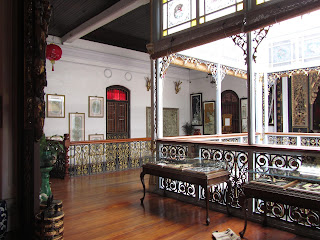It's public holiday time for Tomb Sweeping Festival (Qing Ming). You can see from the Apr 5th 2010 blog what local people do in the parks at this time. I decided to stay in and avoid the crowds. I have tidied up my Malaysia and Sri Lanka photos, and post some here for you.
Penang is about a 5 hr drive from KL, and is the most populated state of Malaysia. Penang Island has over 700,000 inhabitants, almost a half Chinese and 10% Indian.
I went there with a local friend recently, and he showed us round this highly developed and thriving tourist city. Yet it still retains it's colonial charm which enabled it to be declared a UNESCO World Heritage site in 2008.
The old town Georgetown is being bought up by savvy investors and renovated into boutique hotels, cafes and restaurants.
This colonial building from British imperial days is now a hotel. The British were here since the 1780s in one way or another, with independence granted in 1957.

The obvious Chinese influence is not surprising since trade between Penang and China had already started in Admiral Zheng He's time in the 15th century.

The British profited from their rule but also some Chinese immigrants were very successful too. This 'blue house' was built by such a person, Cheung Fatt Tze, who arrived penniless from Guangzhou in 1856 at the age of 16. He was called " One of China's last Mandarins and 1st Capitalist". The mansion contains gothic louvred windows, Chinese porcelain, Stoke-on-Trent (UK) floor tiles, Scottish cast iron and Art Nouveau stained glass. Again quite different from the grand family mansions in Pingyao, China.
Whilst his great entrepreneurial skills did not last many generations, his name survives under the Changyu label, one of the first grape wines to be made in China.
 The locals Malays are Muslims, but the Chinese also built their own temples, which are quite different from the ones we have in Beijing - much more colourful and more elaborate decorations on the walls and roof.
The locals Malays are Muslims, but the Chinese also built their own temples, which are quite different from the ones we have in Beijing - much more colourful and more elaborate decorations on the walls and roof.
You can see how multi-cultural Penang is just from the road signs and shop signs. How many languages can you see in this sign?

........hence the name!
The weather is very hot all year round so it's always time for a drink...this one made from freshly squeezed cane sugar.
We came across another great courtyard house built by a rich Baba more than a century ago. It is one of the most beautiful Chinese mansions I have ever seen! The family must have been very rich!

They also liked some Western things, such as the Scottish ironworks, long European style teak dining table and the stained glass windows, quite a novelty at that time.

I wouldn't mind living here!
Here is the traditional ancestral family worshipping hall, where the names of ancestors were put on plaques like an altar.

..........Buffet Chinese style!
Our friend also took us to a local restaurant famous for its chicken rice.





















hi ! nice photos - very nice places - really interesting !! fantastic !!
ReplyDelete